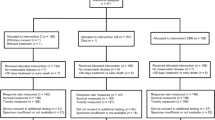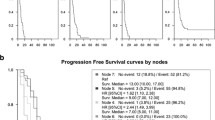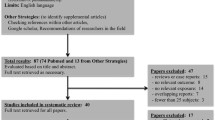Abstract
Background
Despite extensive translational research, no validated biomarkers predictive of bevacizumab treatment outcome have been identified.
Methods
We performed a meta-analysis of individual patient data from six randomized phase III trials in colorectal, pancreatic, lung, renal, breast, and gastric cancer to explore the potential relationships between 195 common genetic variants in the vascular endothelial growth factor (VEGF) pathway and bevacizumab treatment outcome.
Results
The analysis included 1,402 patients (716 bevacizumab-treated and 686 placebo-treated). Twenty variants were associated (P < 0.05) with progression-free survival (PFS) in bevacizumab-treated patients. Of these, 4 variants in EPAS1 survived correction for multiple testing (q < 0.05). Genotype-by-treatment interaction tests revealed that, across these 20 variants, 3 variants in VEGF-C (rs12510099), EPAS1 (rs4953344), and IL8RA (rs2234671) were potentially predictive (P < 0.05), but not resistant to multiple testing (q > 0.05). A weak genotype-by-treatment interaction effect was also observed for rs699946 in VEGF-A, whereas Bayesian genewise analysis revealed that genetic variability in VHL was associated with PFS in the bevacizumab arm (q < 0.05). Variants in VEGF-A, EPAS1, and VHL were located in expression quantitative loci derived from lymphoblastoid cell lines, indicating that they affect the expression levels of their respective gene.
Conclusions
This large genetic analysis suggests that variants in VEGF-A, EPAS1, IL8RA, VHL, and VEGF-C have potential value in predicting bevacizumab treatment outcome across tumor types. Although these associations did not survive correction for multiple testing in a genotype-by-interaction analysis, they are among the strongest predictive effects reported to date for genetic variants and bevacizumab efficacy.





Similar content being viewed by others
References
Hurwitz H, Fehrenbacher L, Novotny W et al (2004) Bevacizumab plus irinotecan, fluorouracil, and leucovorin for metastatic colorectal cancer. N Engl J Med 350(23):2335–2342. doi:10.1056/NEJMoa032691
Sandler A, Gray R, Perry MC et al (2006) Paclitaxel–carboplatin alone or with bevacizumab for non-small-cell lung cancer. N Engl J Med 355(24):2542–2550. doi:10.1056/NEJMoa061884
Miller K, Wang ML, Gralow J et al (2007) Paclitaxel plus bevacizumab versus paclitaxel alone for metastatic breast cancer. New Engl J Med 357(26):2666–2676. doi:10.1056/Nejmoa072113
Miles DW, Chan A, Dirix LY et al (2010) Phase III study of bevacizumab plus docetaxel compared with placebo plus docetaxel for the first-line treatment of human epidermal growth factor receptor 2-negative metastatic breast cancer. J Clin Oncol 28(20):3239–3247. doi:10.1200/JCO.2008.21.6457
Robert NJ, Dieras V, Glaspy J et al (2011) RIBBON-1: randomized, double-blind, placebo-controlled, phase III trial of chemotherapy with or without bevacizumab for first-line treatment of human epidermal growth factor receptor 2-negative, locally recurrent or metastatic breast cancer. J Clin Oncol 29(10):1252–1260. doi:10.1200/Jco.2010.28.0982
Escudier B, Pluzanska A, Koralewski P et al (2007) Bevacizumab plus interferon alfa-2a for treatment of metastatic renal cell carcinoma: a randomised, double-blind phase III trial. Lancet 370(9605):2103–2111. doi:10.1016/S0140-6736(07)61904-7
Burger RA, Brady MF, Bookman MA et al (2011) Incorporation of bevacizumab in the primary treatment of ovarian cancer. N Engl J Med 365(26):2473–2483. doi:10.1056/NEJMoa1104390
Perren TJ, Swart AM, Pfisterer J et al (2011) A phase 3 trial of bevacizumab in ovarian cancer. N Engl J Med 365(26):2484–2496. doi:10.1056/NEJMoa1103799
Aghajanian C, Blank SV, Goff BA et al (2012) OCEANS: a randomized, double-blind, placebo-controlled phase III trial of chemotherapy with or without bevacizumab in patients with platinum-sensitive recurrent epithelial ovarian, primary peritoneal, or fallopian tube cancer. J Clin Oncol 30(17):2039–2045. doi:10.1200/Jco.2012.42.0505
Henriksoon R, Bottomley A, Mason W, Saran F, Wick W, Nishikawa R (2013) Progression-free survival and health-related quality of life in AVAglio, a phase III study of bevacizumab, temozolomide, and radiotherapy in newly diagnosed glioblastoma. J Clin Oncol 31 (Suppl. abstr 2005). http://meetinglibrary.asco.org/content/114612-132
Maru D, Venook AP, Ellis LM (2013) Predictive biomarkers for bevacizumab: are we there yet? Clin Cancer Res 19(11):2824–2827. doi:10.1158/1078-0432.Ccr-12-3409
Sennino B, McDonald DM (2012) Controlling escape from angiogenesis inhibitors. Nat Rev Cancer 12(10):699–709. doi:10.1038/Nrc3366
Bergers G, Hanahan D (2008) Modes of resistance to anti-angiogenic therapy. Nat Rev Cancer 8(8):592–603. doi:10.1038/Nrc2442
Eichten A, Adler AP, Cooper B et al (2013) Rapid decrease in tumor perfusion following VEGF blockade predicts long-term tumor growth inhibition in preclinical tumor models. Angiogenesis 16(2):429–441. doi:10.1007/s10456-012-9328-3
Lambrechts D, Lenz HJ, de Haas S, Carmeliet P, Scherer SJ (2013) Markers of response for the antiangiogenic agent bevacizumab. J Clin Oncol 31(9):1219–1230. doi:10.1200/Jco.2012.46.2762
Brauer MJ, Zhuang GL, Schmidt M et al (2013) Identification and analysis of in vivo VEGF downstream markers link VEGF pathway activity with efficacy of anti-VEGF therapies. Clin Cancer Res 19(13):3681–3692. doi:10.1158/1078-0432.Ccr-12-3635
Hegde PS, Jubb AM, Chen DF et al (2013) Predictive impact of circulating vascular endothelial growth factor in four phase III trials evaluating bevacizumab. Clin Cancer Res 19(4):929–937. doi:10.1158/1078-0432.Ccr-12-2535
Loupakis F, Cremolini C, Fioravanti A et al (2011) Pharmacodynamic and pharmacogenetic angiogenesis-related markers of first-line FOLFOXIRI plus bevacizumab schedule in metastatic colorectal cancer. Br J Cancer 104(8):1262–1269. doi:10.1038/Bjc.2011.85
Zhang W, Dahlberg SE, Yang D et al (2009) Genetic variants in angiogenesis pathway associated with clinical outcome in NSCLC patients (pts) treated with bevacizumab in combination with carboplatin and paclitaxel: subset pharmacogenetic analysis of ECOG 4599 [abstr 8032]. J Clin Oncol 27(15 Suppl.):414s. http://meetinglibrary.asco.org/content/33186-65
Schneider BP, Wang M, Radovich M et al (2008) Association of vascular endothelial growth factor and vascular endothelial growth factor receptor-2 genetic polymorphisms with outcome in a trial of paclitaxel compared with paclitaxel plus bevacizumab in advanced breast cancer: ECOG 2100. J Clin Oncol 26(28):4672–4678. doi:10.1200/JCO.2008.16.1612
Jubb AM, Harris AL (2010) Biomarkers to predict the clinical efficacy of bevacizumab in cancer. Lancet Oncol 11(12):1172–1183. doi:10.1016/S1470-2045(10)70232-1
Gerger A, El-Khoueiry A, Zhang W et al (2011) Pharmacogenetic angiogenesis profiling for first-line bevacizumab plus oxaliplatin-based chemotherapy in patients with metastatic colorectal cancer. Clin Cancer Res 17(17):5783–5792. doi:10.1158/1078-0432.CCR-11-1115
Lambrechts D, Claes B, Delmar P et al (2012) VEGF pathway genetic variants as biomarkers of treatment outcome with bevacizumab: an analysis of data from the AViTA and AVOREN randomised trials. Lancet Oncol 13(7):724–733. doi:10.1016/S1470-2045(12)70231-0
Hansen TF, Christensen RD, Andersen RF, Spindler KLG, Johnsson A, Jakobsen A (2012) The predictive value of single nucleotide polymorphisms in the VEGF system to the efficacy of first-line treatment with bevacizumab plus chemotherapy in patients with metastatic colorectal cancer results from the Nordic ACT trial. Int J Colorectal Dis 27(6):715–720. doi:10.1007/S00384-011-1382-6
Schneider BP, Gray RJ, Radovich M et al (2013) Prognostic and predictive value of tumor vascular endothelial growth factor gene amplification in metastatic breast cancer treated with paclitaxel with and without bevacizumab; results from ECOG 2100 trial. Clin Cancer Res 19(5):1281–1289. doi:10.1158/1078-0432.Ccr-12-3029
Loupakis F, Cremolini C, Dongyun Y et al (2013) Prospective validation of candidate SNPs of VEGF/VEGFR pathway in metastatic colorectal cancer patients treated with first-line FOLFIRI plus bevacizumab. Plos One 8(7):e66774. doi:10.1371/journal.pone.0066774
Van Cutsem E, Vervenne WL, Bennouna J et al (2009) Phase III trial of bevacizumab in combination with gemcitabine and erlotinib in patients with metastatic pancreatic cancer. J Clin Oncol 27(13):2231–2237. doi:10.1200/JCO.2008.20.0238
Reck M, von Pawel J, Zatloukal P et al (2009) Phase III trial of cisplatin plus gemcitabine with either placebo or bevacizumab as first-line therapy for nonsquamous non-small-cell lung cancer: AVAiL. J Clin Oncol 27(8):1227–1234. doi:10.1200/Jco.2007.14.5466
Ohtsu A, Shah MA, Van Cutsem E et al (2011) Bevacizumab in combination with chemotherapy as first-line therapy in advanced gastric cancer: a randomized, double-blind, placebo-controlled phase III study. J Clin Oncol 29(30):3968–3976. doi:10.1200/Jco.2011.36.2236
Barret JC (2009) Haploview: visualization and analysis of SNP genotype data. Cold Spring Harb Protoc 10:pdb.ip71. doi:10.1101/pdb.ip71
Pettersson FH, Anderson CA, Clarke GM et al (2009) Marker selection for genetic case–control association studies. Nat Protoc 4(5):743–752. doi:10.1038/Nprot.2009.38
Lambrechts D, Moisse M, Delmar P et al (2014) Genetic markers of bevacizumab-induced hypertension. Angiogenesis. doi:10.1007/s10456-014-9424-7
Grundberg E, Small KS, Hedman AK et al (2012) Mapping cis- and trans-regulatory effects across multiple tissues in twins. Nat Genet 44(10):1084–1089. doi:10.1038/ng.2394
Yang TP, Beazley C, Montgomery SB et al (2010) Genevar: a database and Java application for the analysis and visualization of SNP-gene associations in eQTL studies. Bioinformatics 26(19):2474–2476. doi:10.1093/bioinformatics/btq452
Benjamini Y, Hochberg Y (1995) Controlling the false discovery rate—a practical and powerful approach to multiple testing. J R Stat Soc B 57(1):289–300
Goeman JJ, van de Geer SA, de Kort F, van Houwelingen HC (2004) A global test for groups of genes: testing association with clinical outcome. Bioinformatics 20:93–99
Goeman JJ, Oosting J, Cleton-Jansen AM, Anninga JK, van Houwelingen HC (2005) Testing association of a pathway with survival using gene expression data. Bioinformatics 21(9):1950–1957. doi:10.1093/Bioinformatics/Bti267
Zou H, Hastie T (2005) Regularization and variable selection via the elastic net. J R Stat Soc B 67:301–320. doi:10.1111/J.1467-9868.2005.00503.X
Friedman J, Hastie T, Tibshirani R (2008) Regularization paths for generalized linear models via coordinate descent. J Stat Soft 33:1–22
Simon N, Friedman J, Hastie T, Tibshirani R (2011) Regularization paths for Cox’s proportional hazards model via coordinate descent. J Stat Soft 39:1–13
Choi I, Lee YS, Chung HK et al (2013) Interleukin-8 reduces post-surgical lymphedema formation by promoting lymphatic vessel regeneration. Angiogenesis 16(1):29–44. doi:10.1007/s10456-012-9297-6
Nakata I, Yamashiro K, Nakanishi H, Tsujikawa A, Otani A, Yoshimura N (2011) VEGF gene polymorphism and response to intravitreal bevacizumab and triple therapy in age-related macular degeneration. Jpn J Ophthalmol 55(5):435–443. doi:10.1007/S10384-011-0061-Z
Chen J, Michan S, Juan AM et al (2013) Neuronal sirtuin1 mediates retinal vascular regeneration in oxygen-induced ischemic retinopathy. Angiogenesis 16(4):985–992. doi:10.1007/s10456-013-9374-5
Xia GB, Kageyama Y, Hayashi T, Kawakami S, Yoshida M, Kihara M (2001) Regulation of vascular endothelial growth factor transcription by endothelial PAS domain protein 1 (EPAS1) and possible involvement of EPAS1 in the angiogenesis of renal cell carcinoma. Cancer 91(8):1429–1436. doi:10.1002/1097-0142(20010415)91:8<1429:Aid-Cncr1149>3.0.Co;2-V
Favier J, Plouin PF, Corvol P, Gasc JM (2002) Angiogenesis and vascular architecture in pheochromocytomas—distinctive traits in malignant tumors. Am J Pathol 161(4):1235–1246. doi:10.1016/S0002-9440(10)64400-8
Favier J, Lapointe S, Maliba R, Sirois MG (2007) HIF2 alpha reduces growth rate but promotes angiogenesis in a mouse model of neuroblastoma. BMC Cancer 7. doi:10.1186/1471-2407-7-139
Keith B, Johnson RS, Simon MC (2011) HIF1α and HIF2α: sibling rivalry in hypoxic tumour growth and progression. Nat Rev Cancer 12:9–22
Jubb AM, Turley H, Moeller HC et al (2009) Expression of delta-like ligand 4 (Dll4) and markers of hypoxia in colon cancer. Br J Cancer 101(10):1749–1757. doi:10.1038/Sj.Bjc.6605368
Talks KL, Turley H, Gatter KC et al (2000) The expression and distribution of the hypoxia-inducible factors HIF-1 alpha and HIF-2 alpha in normal human tissues, cancers, and tumor-associated macrophages. Am J Pathol 157(2):411–421. doi:10.1016/S0002-9440(10)64554-3
Shay JES, Simon MC (2012) Hypoxia-inducible factors: crosstalk between inflammation and metabolism. Semin Cell Dev Biol 23(4):389–394. doi:10.1016/J.Semcdb.04.004
Simonson TS, Yang YZ, Huff CD et al (2010) Genetic evidence for high-altitude adaptation in Tibet. Science 329(5987):72–75. doi:10.1126/Science.1189406
Yi X, Liang Y, Huerta-Sanchez E et al (2010) Sequencing of 50 human exomes reveals adaptation to high altitude. Science 329(5987):75–78. doi:10.1126/Science.1190371
Beall CM, Cavalleri GL, Deng LB et al (2010) Natural selection on EPAS1 (HIF2 alpha) associated with low hemoglobin concentration in Tibetan highlanders. Proc Natl Acad Sci USA 107(25):11459–11464. doi:10.1073/Pnas.1002443107
Lambrechts D, Storkebaum E, Morimoto M et al (2003) VEGF is a modifier of amyotrophic lateral sclerosis in mice and humans and protects motoneurons against ischemic death. Nat Genet 34(4):383–394. doi:10.1038/ng1211
Han SW, Kim GW, Seo JS et al (2004) VEGF gene polymorphisms and susceptibility to rheumatoid arthritis. Rheumatology (Oxf) 43(9):1173–1177. doi:10.1093/rheumatology/keh281
Acknowledgments
We thank all patients who volunteered to participate in the genetic biomarker protocol of these studies and the research staff at the Vesalius Research Center, in particular Gilian Peuteman, Dominiek Smeets, and Thomas Van Brussel. The trials included in this analysis were sponsored and funded by F. Hoffmann-La Roche, Basel, Switzerland. Funding for statistical analyses and third-party medical writing support for this paper were also provided by F. Hoffmann-La Roche. Sanne de Haas and Paul Delmar are employees of F. Hoffmann-La Roche Ltd. Matthieu Moisse is supported by the Fund for Scientific Research Flanders (FWO). The work of Peter Carmeliet is funded by long-term structural funding Methusalem by the Flemish Government. Diether Lambrechts is supported by the Seventh Framework Programme of the European Community for Research (AngioPredict). The trials included in this analysis were sponsored and funded by F. Hoffmann-La Roche, Basel, Switzerland. Funding for statistical analyses and third-party medical writing support for this paper were also provided by F. Hoffmann-La Roche.
Conflict of interest
Sanne de Haas and Paul Delmar are employees of F. Hoffmann-La Roche, Basel, Switzerland. Aruna T. Bansal is a paid consultant of F. Hoffmann-La Roche. Eric Van Cutsem, Diether Lambrechts, and Peter Carmeliet have received research funding from F. Hoffmann-La Roche related to research into biomarkers for bevacizumab. David Miles has received honoraria from F. Hoffmann-La Roche for advisory boards and speaker engagements. Celine Pallaud is a former employee of F. Hoffmann-La Roche, Basel, Switzerland. Stefan Scherer is a former employee of Genentech. The remaining authors have declared no potential conflict of interest.
Author information
Authors and Affiliations
Corresponding author
Additional information
Sanne de Haas and Paul Delmar have contributed equally to this work.
Electronic supplementary material
Below is the link to the electronic supplementary material.
Rights and permissions
About this article
Cite this article
de Haas, S., Delmar, P., Bansal, A.T. et al. Genetic variability of VEGF pathway genes in six randomized phase III trials assessing the addition of bevacizumab to standard therapy. Angiogenesis 17, 909–920 (2014). https://doi.org/10.1007/s10456-014-9438-1
Received:
Accepted:
Published:
Issue Date:
DOI: https://doi.org/10.1007/s10456-014-9438-1




